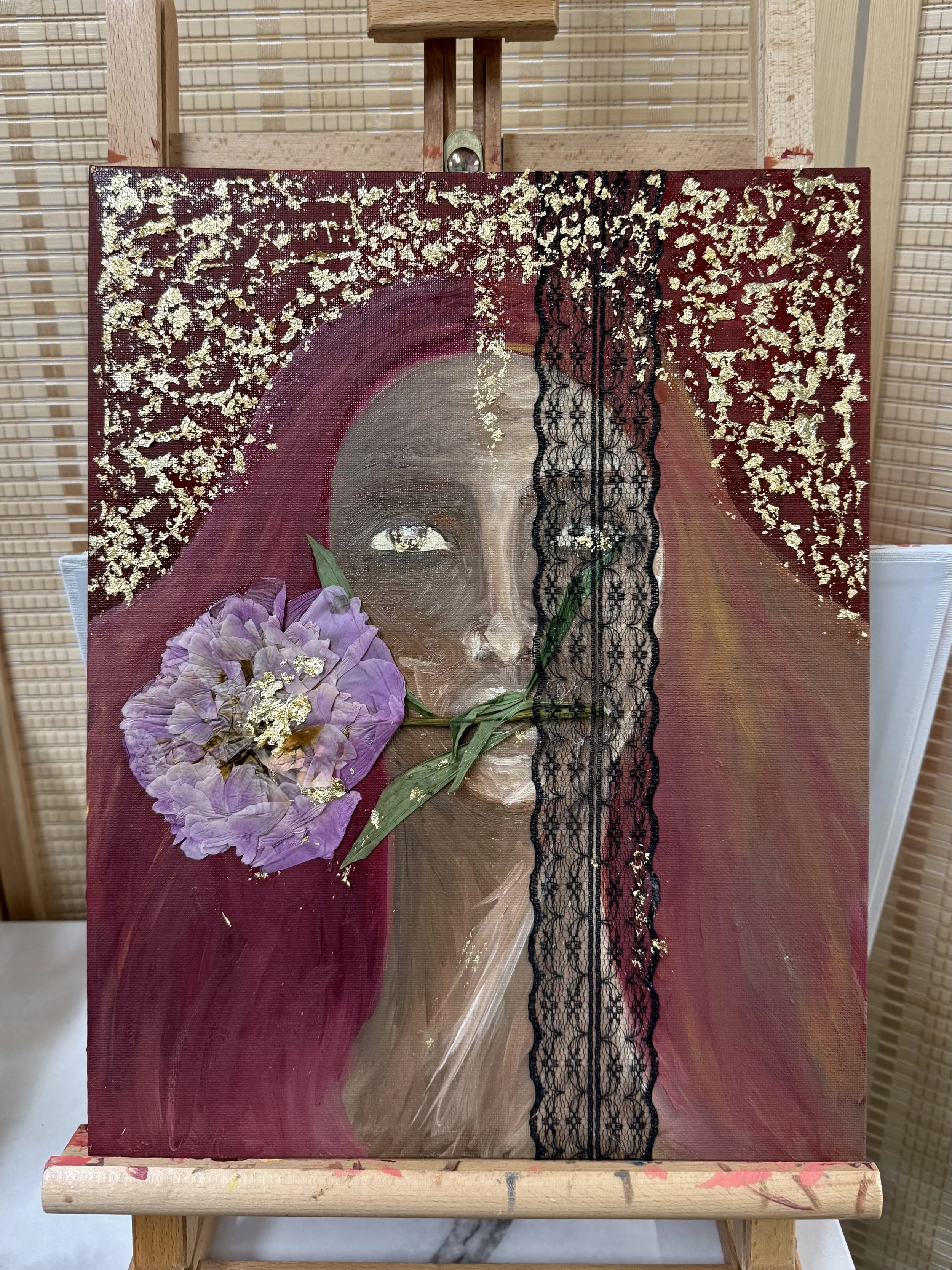 Image 1 of 3
Image 1 of 3

 Image 2 of 3
Image 2 of 3

 Image 3 of 3
Image 3 of 3




The Flower Sermon
The Flower Sermon
This mixed media piece invites you to sit in the paradox:
Light is but an illusion. Through shadow lies the truth in nature.
Oil paint forms the base of the portrait, split between a shadowed left and a luminous right. But it is the lighter side of the face that is veiled by black lace.
Lace represents the illusion of “light” in a performative, surface-level world. Like illusion, it is beautiful, elegant, and seductive. And also a trap. It is not always darkness that keeps us asleep, but the polished surface of a comfortable life.
Here, light becomes the veil.
The shadowed half of the face is unveiled. No ornaments. No coverings. It is dark, real, and true—like the mud from which a lotus grows. The darkness, the mud, holds the potential for liberation. But only if we dare to meet it.
A real dried peony is placed across the mouth. Flowers bloom in a flash, quickly fade, decay, and return to nature. This one has been dried as a paradoxical reminder that impermanence is the truth in nature.
The flower, though faded, is more real than the painted woman’s face.
Truth often hides beneath appearances and in the depth of what has withstood death.
Gold leaf symbolizes divine light. All around us and within us. It marks the third eye, throat (Vishuddha chakra), and neck as portals of perception, speech, and truth. Gold also fills the eyes, inviting us to see beyond illusion and into what is.
The lace reminds us that performative light is the illusion.
The dried flower reminds us that in the shadow is the light.
This work is a visual koan.
A Zen riddle of perception.
An offering.
— Original painting/mixed media by Zen Teacher Nadia Mounsif (11×14)
The Flower Sermon
This mixed media piece invites you to sit in the paradox:
Light is but an illusion. Through shadow lies the truth in nature.
Oil paint forms the base of the portrait, split between a shadowed left and a luminous right. But it is the lighter side of the face that is veiled by black lace.
Lace represents the illusion of “light” in a performative, surface-level world. Like illusion, it is beautiful, elegant, and seductive. And also a trap. It is not always darkness that keeps us asleep, but the polished surface of a comfortable life.
Here, light becomes the veil.
The shadowed half of the face is unveiled. No ornaments. No coverings. It is dark, real, and true—like the mud from which a lotus grows. The darkness, the mud, holds the potential for liberation. But only if we dare to meet it.
A real dried peony is placed across the mouth. Flowers bloom in a flash, quickly fade, decay, and return to nature. This one has been dried as a paradoxical reminder that impermanence is the truth in nature.
The flower, though faded, is more real than the painted woman’s face.
Truth often hides beneath appearances and in the depth of what has withstood death.
Gold leaf symbolizes divine light. All around us and within us. It marks the third eye, throat (Vishuddha chakra), and neck as portals of perception, speech, and truth. Gold also fills the eyes, inviting us to see beyond illusion and into what is.
The lace reminds us that performative light is the illusion.
The dried flower reminds us that in the shadow is the light.
This work is a visual koan.
A Zen riddle of perception.
An offering.
— Original painting/mixed media by Zen Teacher Nadia Mounsif (11×14)